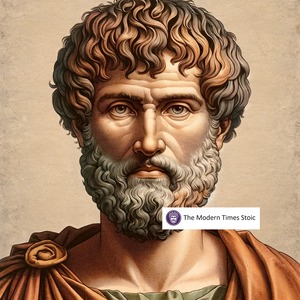Stoicism cannot be mastered overnight. The promise of the good life can only be achieved with the perpetual practice of the principles and techniques of the ancient philosophy. A practicing might ask “How do we know if we have reaped the fruits of Stoicism”. In other words, what are the indicators that we have truly caught the wisdom of the philosophy? There is truth in the saying “you can’t manage what you can measure”. We need to have some metrics that we can refer to if we are to evaluate our progress in applying the teachings of Stoicism.
In this article, I present 8 aspects in our lives that we can look into if we really lived up to the philosophy of Stoicism. The majority of these metrics came from the book of Professor William Irvine, A Guide to the Good Life, which in my opinion one of the best books on Stoicism. In my journal, How I Write My Stoic Journals, I go through this list every day and reflect which among these have I done well or not and then make a plan on how I could improve.
1. Emotional Stability
Emotional stability comes mainly from one of the central tenets of Stoicism that we cannot control almost everything around us. If we come to terms with this fundamental fact(such as we put incorporate this into our everyday practice) we can cut off a lot of the negative emotions and become less reactive to external events such as other people’s bad behavior or when we get stuck into traffic. Stoicism teaches as UNCONDITIONAL ACCEPTANCE to other people and life circumstances because the only thing we have control over are our thoughts, emotions, and behavior.
2. Less Social Approval Seeking Behaviors
This includes posting on social media for the sole purpose of gathering likes, reactions, and shares. The problem with this kind of behavior is that it feeds our ego unknowingly and we will live in the illusion that the world is revolving with us at the center of the universe. We derive our worth and happiness on outside approval which is fleeting. The Stoics have always reminded us to derive our strength, peace, and happiness from within – from being good and doing the right things which color our soul. So the next thing you feel the urge of some egoistic social approval-seeking behavior such as posting what you eat the entire day, imagine Seneca or Epictetus across the opposite table with cardboard saying “WE DON’T CARE.”. Of course, I’m not advocating not to post anything on social media. I’m only saying minimize them as much as possible because it will train you to depend your happiness on externals which the Stoics would definitely disagree.
3. Improved Relationship with other People
When we truly have internalized what he Stoics said that we and people dear to us “could leave right now” as Marcus Aurelius famously said we would realize how futile our negative attitudes towards others are. The Stoics negative visualization technique helps us appreciate more the things that we have especially our mortal loved ones. It keeps our focus on positive experiences rather than dwell on the unnecessary negative feelings we have for them.
4. Control Desire
Stoics’ deep understanding of the nature of desire can be traced from their Cynic bloodlines whose core doctrine involves complete aversion from desire. By understanding the stealthy impact of pleasure along with some Stoics techniques such as negative visualization an experienced practicing stoic should be able to make sound judgments as to what pleasure to pursue or not.
“The frail body involves us in vain pleasures, short-lived, and soon to be regretted, which unless they are reined in by extreme self-control, will be transformed into the opposite... Pleasure, unless, it has been kept within bounds, tends to rush headlong into the abyss of sorrow.”
Seneca Tweet This Quote
5. Action-Oriented and Less Talk
Stoicism is a philosophy meant for practical use. All the ancient Stoics are high profiled men who were committed to incorporate the philosophy in their field of endeavors. They walked the talk. Seneca said that our actions should be consistent with what we preach. Reading and posting quotes on Stoicism does not take us anywhere, we will forget them soon enough. The only way we can say that we made progress with Stoicism is if we carry its teachings along with our professions.
“Don’t explain your philosophy. Embody it.”
Epictetus Tweet This Quote
6. Stops Blaming Other People
If we find ourselves still blaming other people that means our happiness is still dependent on external factors. Stoicism requires total ownership of our perceptions, emotions, and actions.
7. Composure
The ancient Stoics were fierce rationalists. They always emphasized the importance of seeing things for what they truly are and not trust our quick impulses. To live in accordance with nature means to act rationally at all times. Using our reason would sometimes require habitual poses and calming our nerves to make sense of the compelling situation.
8. Remove Fear of Death
Among these aspects, removing the fear of death is the hardest to assess because we will only know when we are at our death bed. Even Seneca who made the most explicit taunts on death among the ancient Stoics said that the ultimate test of our courage and Stoicism for that matter is when we are about the draw our last breath. The least we can do is to evaluate our reaction when people near or dear to us is about to depart. We made a bit of progress when can embrace it with more acceptance, understanding that death is part of the laws of nature.
In my daily meditations and journaling, I always reflect on these things such as whether I maintained my composure for the day or I easily reacted to events, whether I act rationally or impulsively, whether I posted on social media for the sole purpose of getting approval, etc. Nonetheless, the Stoics would be the first to admit that these things are not easy to practice and we will never be brought them to perfection. But by constantly practicing them, we can be assured of a life better than simply indulging ourselves with our impulses, quickly reacting to random events, or drowning ourselves with our petty anxieties.
If you found this list helpful, feel free to BOOKMARK this page should you want to use it in your personal meditation journal.







